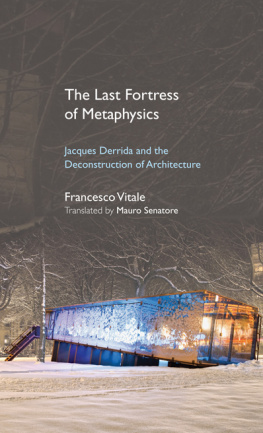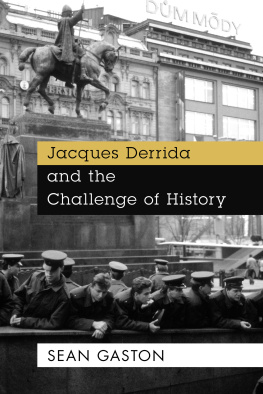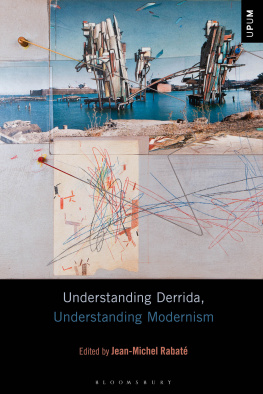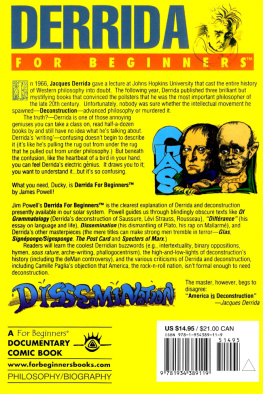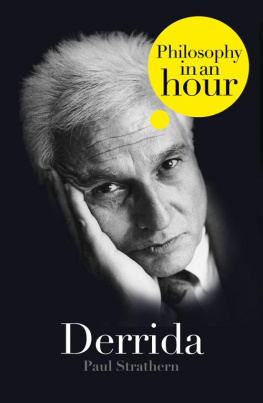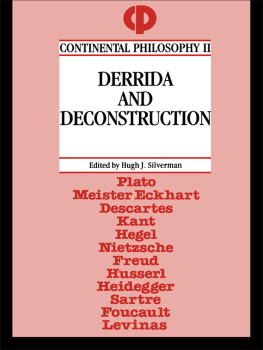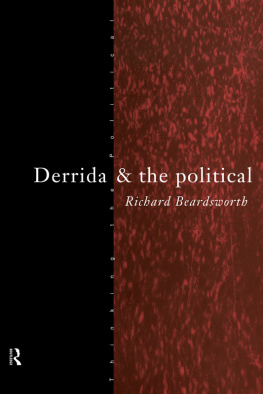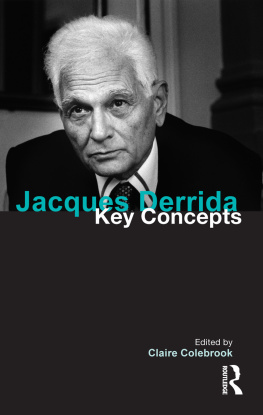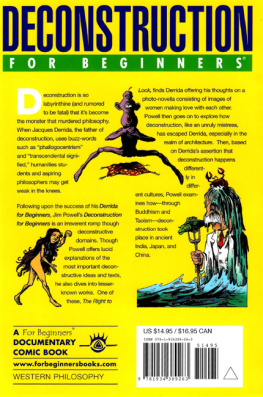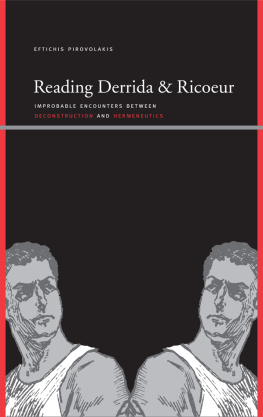The Last Fortress
of Metaphysics
SUNY Series, Intersections: Philosophy and Critical Theory
Rodolphe Gasch, editor
THE LAST FORTRESS
OF METAPHYSICS
Jacques Derrida and the
Deconstruction of Architecture
Francesco Vitale
translated by Mauro Senatore
Cover photo of Tschumipaviljoen taken by Peter van Aller (from Groningen, The Netherlands). Retrieved from Wikimedia Commons.
Published by State University of New York Press, Albany
2018 State University of New York
All rights reserved
Printed in the United States of America
No part of this book may be used or reproduced in any manner whatsoever without written permission. No part of this book may be stored in a retrieval system or transmitted in any form or by any means including electronic, electrostatic, magnetic tape, mechanical, photocopying, recording, or otherwise without the prior permission in writing of the publisher.
For information, contact State University of New York Press, Albany, NY
www.sunypress.edu
Production, Diane Ganeles
Marketing, Kate Seburyamo
Book design, Aimee Harrison
Library of Congress Cataloging-in-Publication Data
Names: Vitale, Francesco, author| Senatore, Mauro, translator
Title: The last fortress of metaphysics : Jacques Derrida and the deconstruction of architecture / Francesco Vitale, author
Description: Albany : State University of New York Press, [2018] | Series: SUNY series, intersections : philosophy and critical theory.
Identifiers: ISBN 9781438469355 (hardcover : alk. paper) | ISBN 9781438469379 (e-book)
Further information is available at the Library of Congress.
10 9 8 7 6 5 4 3 2 1
CONTENTS
ACKNOWLEDGMENTS
I MUST THANK RODOLPHE GASCH NOT ONLY FOR WELCOMING this book in his series but also for his teaching, which has accompanied me for years through the reading of Jacques Derrida, and above all for his friendship, which I consider the most precious of his gifts. I must also thank another master, the architect and theorist of architecture Vittorio Gregotti. I owe him the understanding of the (not only theoretical) stakes of the translation of deconstruction from philosophical writing to the theory and praxis of architecture. My thanks go also to Giovanna Borradori with whom I discussed almost every passage of this book; to Geoffrey Bennington for some essential remarks; to Peter Bojanic, who invited me to the conference Architecture of Deconstruction: The Specter of Jacques Derrida (Belgrade, 2527 October 2012), thus giving me the opportunity to engage with architects and theorists of deconstructivism such as Eisenman, Tschumi, Kipnis, Cousin; to Francesco Rispoli, professor of architectural composition at the University Federico II, in Naples, who helped me deepen and test my architectural competencies; to Armando Sichenze, who invited me as a visiting professor to lead seminars on Architecture and Deconstruction at the Universit della Basilicata, in Matera (Italy) from 2013 to 2015; to the architect Hosea Scelza, lifelong friend, who transferred to me the passion for architecture many years ago and with whom I designed the house where I live; to Andrea Canclini, Giovanni Durbiano, and Alessandro Armando, with whom I was able to discuss my theses on the relationship between deconstruction and deconstructivism, on the occasion of the lecture held at the Polytechnic University in Turin, in July 2015, and to Donald Cross, who helped me with proofreading. Finally, I thank Mme. Marguerite Derrida for allowing me to quote a few unedited texts from Derridas archives at the IMEC, in Caen, and Bernard Tschumi for permission to use some pictures from his book The Manhattan Transcripts.
Derrida scholars will forgive me for simplifying the thought of the philosopher that I consider the master of masters. I believed it was necessary to make this work accessible to my friends who are architects and scholars of architecture. The latter will forgive me if, despite my best efforts, I havent succeeded in my attempt at simplifying.
Some essays published in this volume originally appeared in Italian: Introduction: The Last Fortress of Metaphysics was included as the introduction to the volume in which I collected Derridas writing on architecture, J. Derrida, Adesso larchitettura, a cura di F. Vitale (Milano: Scheiwiller, 2008); The Law of the Oikos: Jacques Derrida and the Deconstruction of the Dwelling develops the paper presented at the conference Architecture of Deconstruction: The Specter of Jacques Derrida (Belgrade, 2527 October 2012); Mythographies: Toward an Architectural Writing and Writing Space: Between Tschumi and Derrida were published with different titles in my Mitografie: Jacques Derrida e la scrittura dello spazio (Milano: Mimesis, 2012); Spacing: The Architecture of Deconstruction appeared in Annali della Fondazione Europea del Disegno (Fondation Adami), 2008/IV.
INTRODUCTION
THE INTEREST IN ARCHITECTURE CIRCUMSCRIBES A SPECIFIC moment of Jacques Derridas work, at least at first glance: from Labirinth und Architextur To make the argument explicit, I begin by situating Derridas work on architecture within a framework that clears confusing traces from the field of investigation and focuses on those traces that seem to be more pertinent for our investigation.
Each time unique. The encounter with architecture
Accidental and necessary at once: thus Derrida defines his encounter with architecture, namely, the relationship between deconstruction and architecture, according to a movement that is apparently contradictory and yet always at work in Derridas writing, a movement that allows us to understand the general strategy underwriting his interventions on architecture as well as the singular character of each of them. We must take this movement into account; otherwise, we might run the risk of considering these interventions to be mere exercises of style, if not the occasional performances of a word magicianas Derrida still is for many readers. Indeed, it is not by chance that, declaring himself obstinately incompetent, Derrida recalls the surprise of that first time that inaugurated the series of subsequent encounters. Each time he goes back to the encounter with Tschumi and Eisenman and starts over. However, in so doing, he does not so much mean to gain the indulgence of his expert interlocutor as to shake a set of presuppositions that, remaining implicit, would affect the discourse about architecture, the relationship between architecture and deconstruction, according to a program that risks being taken as self-evident. Above all, Derrida does not mean to fall back into a classical philosophical position, which is rather to be contested: the absolute hierarchical privilege philosophy gives itself against the other fields of knowledge as the exclusive holder of the true discourse, the discourse all the other fields must refer to as the last instance. According to this schema, the philosopher to whom the architect appeals would be authorized to say the truth, the meaning, and destinythe very essenceof architecture, which the architect is unable to grasp. The latter would be lost in his or her practice, which is always restricted even when strictly theoretical.
Although we are far from this tradition today, we still encounter this behavior, and not only in the field of architecture. Therefore, Derrida eludes the traditional form of the philosophical essay and prefers a direct confrontation, a discussion and exchange that are equal and take place in a public space, recognizable and shared. Indeed, he warns his interlocutors not to seek in his discourse a prescription valid for architecture and rather prefers to offer provocative and sometimes polemical observations. Furthermore, he does not give explicit definitions; he prefers raising questions to responding to them. Given the ironic tone and the elliptical form of his discourse, we may designate Derridas position as

